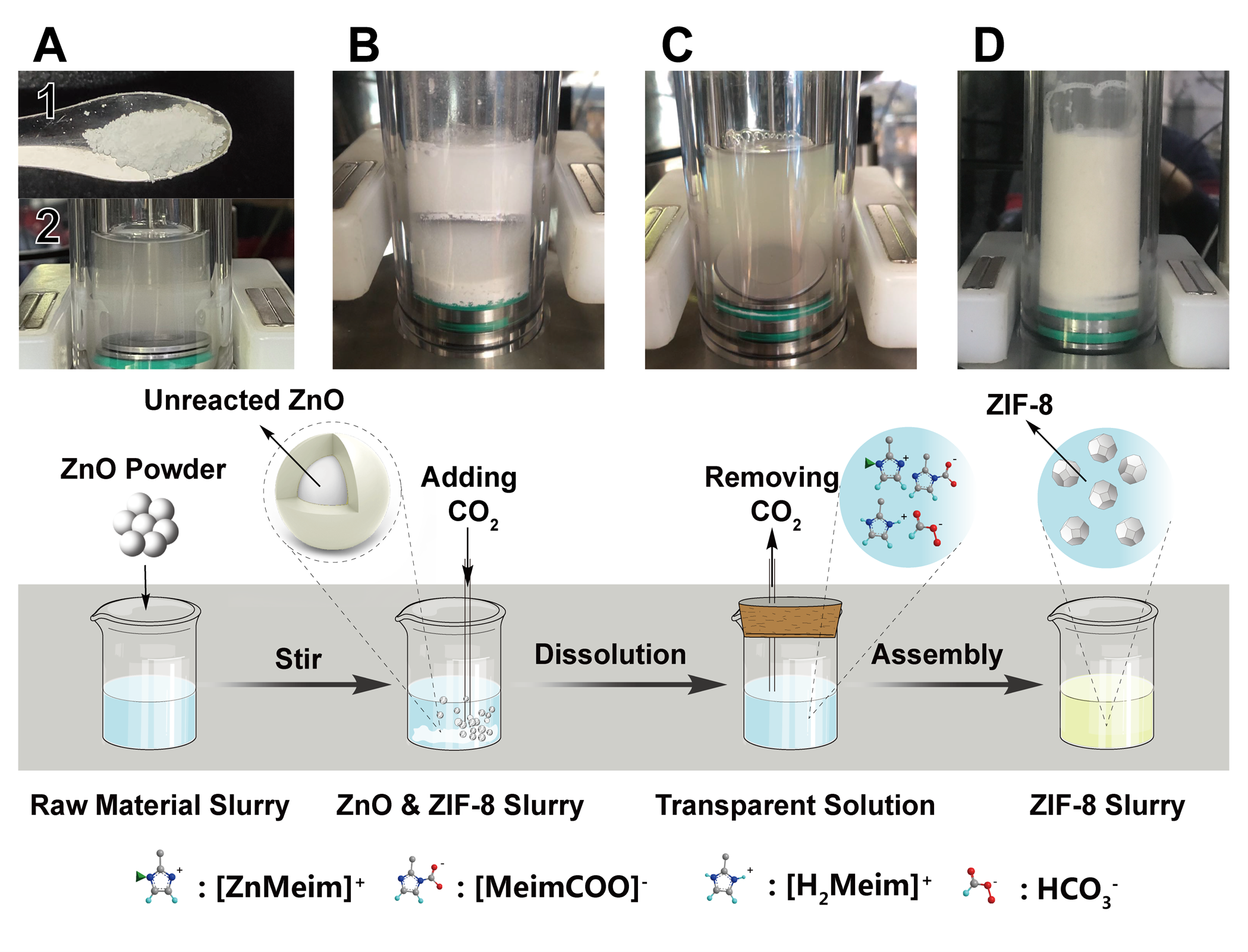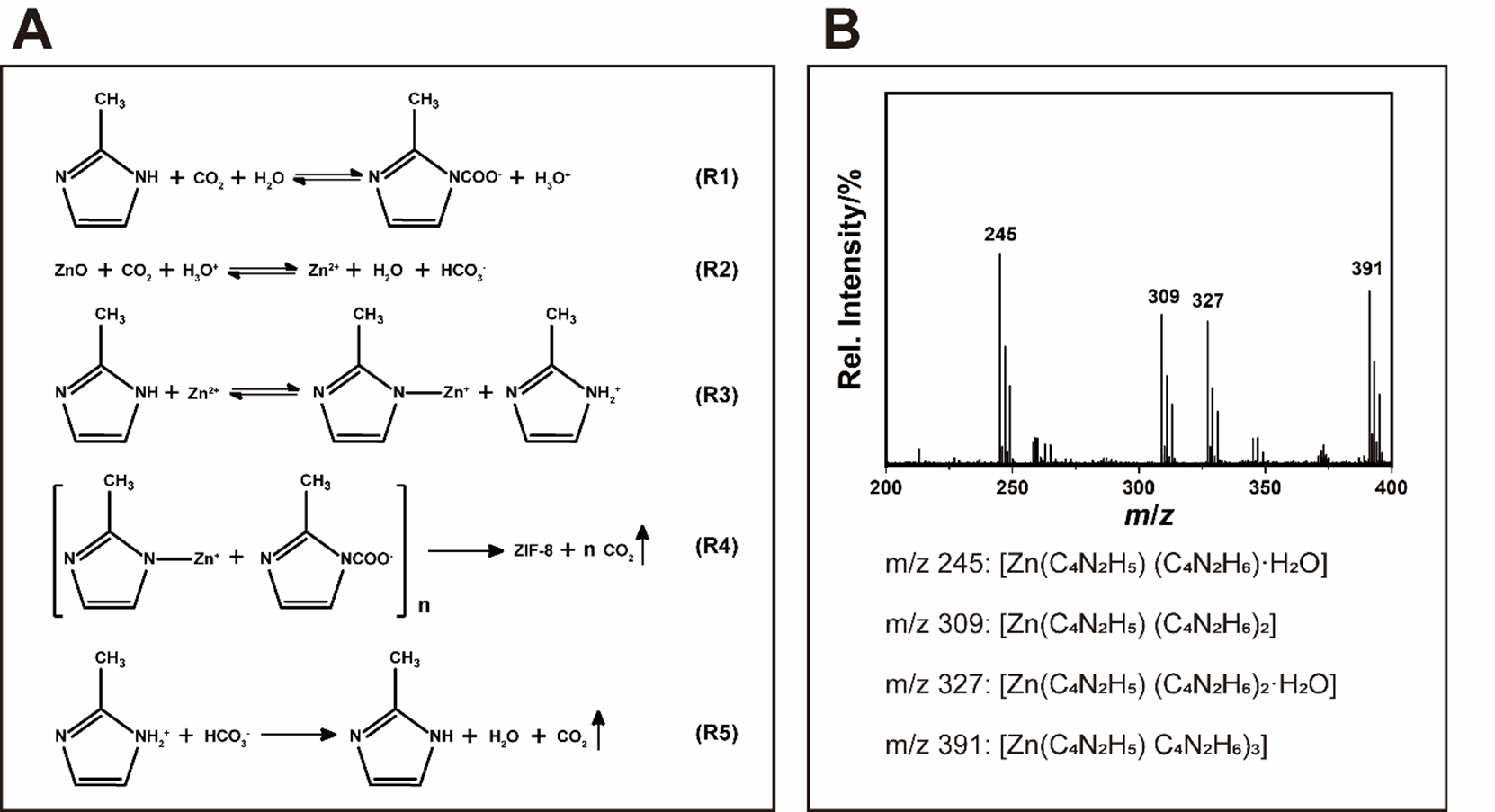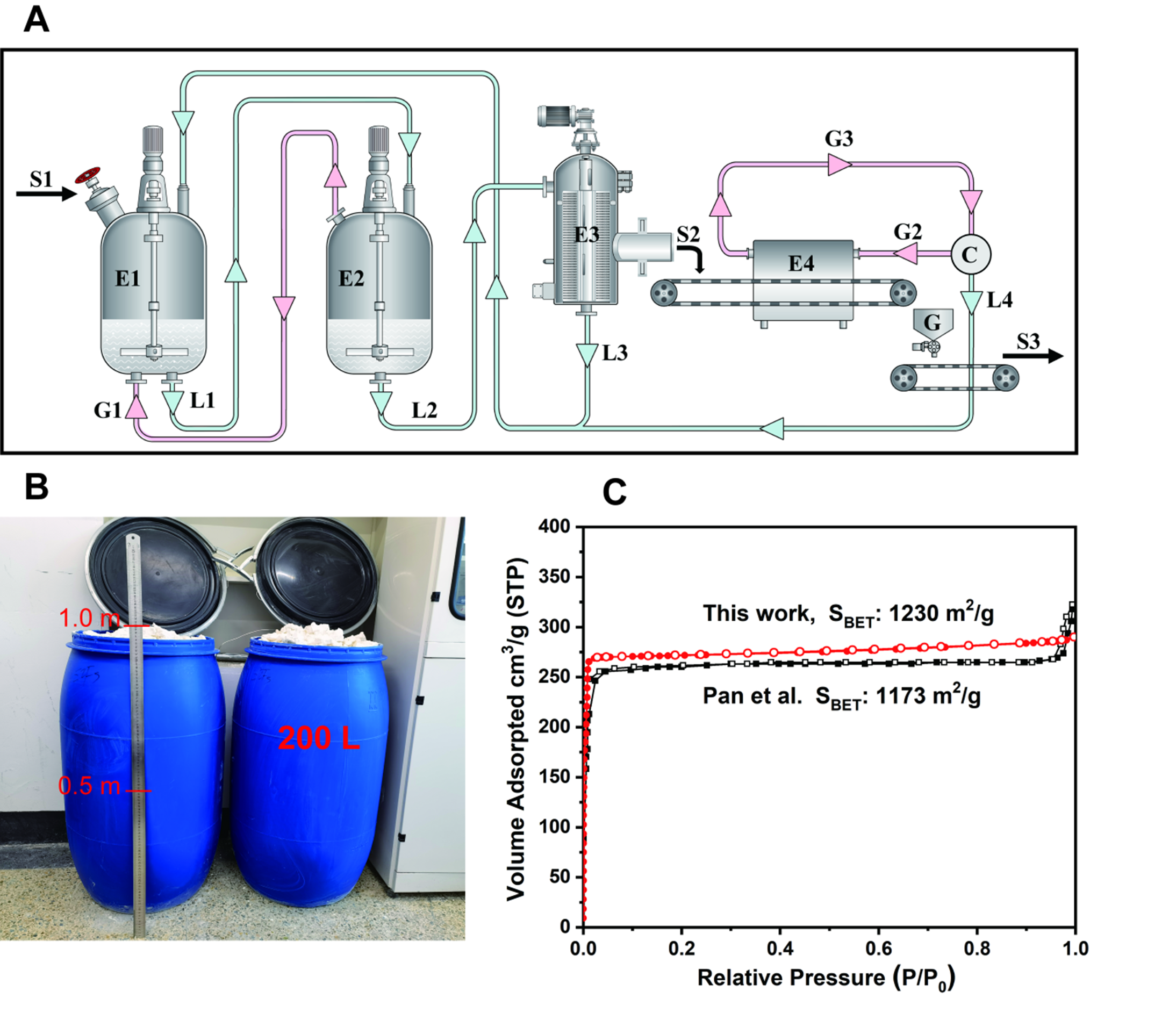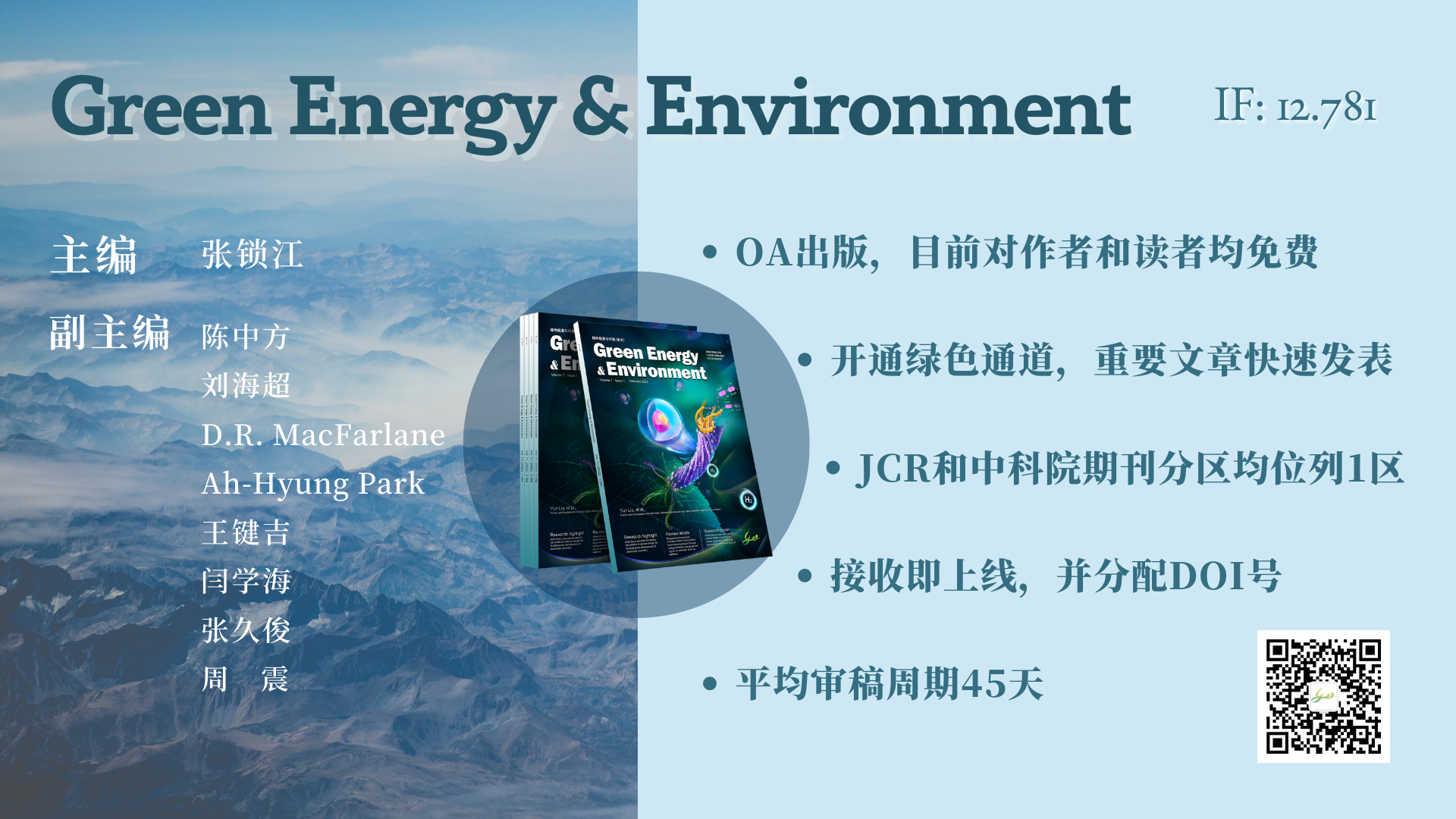博文
中国石油大学(北京)陈光进教授、刘蓓教授团队和北京化工大学曹达鹏教授团队GEE:CO2辅助法绿色高效合成ZIFs
|


研究背景
金属咪唑酯骨架材料(ZIFs)材料从发现至今已有十多年,科研工作者在ZIFs材料的应用性能研究上投入大量的科研精力,但是ZIFs仍未被商业应用,合成成本是限制其商业化的重要因素之一。目前已报道的ZIFs材料合成工艺主要分为两类:第一类是以可溶性金属盐(如硝酸锌、醋酸锌等)为金属源的溶剂搅拌法,该工艺过滤的湿基材料中有残余的可溶性金属盐和添加剂,需使用大量溶剂反复清洗才能得到纯度较高的ZIFs材料,另外合成后产生的滤液中存在强酸性阴离子,反应中添加的碱性添加剂无法重复利用,被当作含酸废水处理,这些都显著增加了合成成本;第二类是以金属氧化物为金属源的机械研磨法,该方法合成产物为ZIFs和水,易于提纯,但是反应时间较长、金属氧化物转化不彻底和不易工业放大是目前待解决的问题。 基于以上两种合成工艺面临的问题,课题组开发了CO2辅助法合成ZIFs,该方法解决了氧化锌难溶于溶剂的问题,使非均相反应成为均相反应,不使用机械研磨也可以提高氧化锌的转化率达95%。该合成方法可在常温和常压下进行,产物易于提纯,母液可重复利用从而避免了溶剂浪费,还可以通过调节CO2的脱除速率调控成核和生长速率,进而调控晶体形貌和尺寸。CO2廉价、无毒且不易燃,在提高合成效率的同时可以保持较低的合成成本。
图文解读 CO2辅助合成步骤如图1所示。以合成ZIF-8为例,首先将ZnO、2-甲基咪唑和水混合形成白色浆液(图1A和B),将CO2通入浆液中直到固液混相变为均相溶液(图C),此时ZnO溶解,通过加热或减压的方式移除溶液中的CO2后,均相溶液重新变为固液混相的浆液(图D),此时浆液的成分变为2-甲基咪唑、水和ZIF-8。这种溶解-自组装的ZIFs合成方式同时具备溶剂搅拌法和机械研磨法的优点,可以在无机械研磨的条件下提高ZnO转化率,并且合成产物只有水和ZIF-8,滤液也可以重复使用。 Fig. 1. The synthesis process of ZIF-8 by using CO2 aided method. (A1) ZnO; (A2) HMeim solution; (B) ZnO and ZIF-8 slurry before adding CO2; (C) Transparent solution after adding CO2; (D) ZIF-8 slurry after removing CO2. Meim represents that HMeim lost a proton. H2Meim represents that HMeim obtained a proton. CO2辅助法合成ZIF-8化学方程式列于图2A,添加CO2后形成均相溶液的电喷雾电离质谱(ESI-MS)分析结果列于图2B。根据反应方程式和质谱结果可知,CO2在合成过程中主要起到两个作用:(1)促进2-甲基咪唑去质子化;(2)产生H3O+促进ZnO溶解到水中形成Zn2+。在水中去质子化的2-甲基咪唑和锌离子形成大量金属咪唑配位阳离子,当CO2移除后,金属咪唑配位阳离子自组装逐渐成核生长合成ZIF-8颗粒。该合成方式不仅可以提高ZnO转化率,并且可以通过控制CO2加入和移除控制ZIF-8成核时间,为后续ZIF-8定向改性提供参考。 Fig. 2. (A): Possible reaction mechanism of the CO2 aided. (B) Positive ion spectrum obtained with full range of 200 to 400 for the transparent solution produced by injecting CO2 in the slurry of ZnO+HMeim+water. C4N2H6 is the molecular formula of HMeim. C4N2H5 is the molecular formula of HMeim lost a proton (Meim). 使用CO2辅助法在不同条件下合成ZIF-8的实验结果列于图3。实验结果表明充分使用CO2可以显著提高ZIF-8的比表面积和收率。多次滤液重复利用结果也表明使用该方法合成ZIF-8产生的滤液可以重复利用,可以减少滤液的后续处理费用。 Fig. 3. (A) XRD patterns, yeild, and SBET of ZIF-8 samples synthesized with different mole ratio (R) of HMeim and zinc. The reaction temperature is 303.15 K and the desorption temperature (Tde) is 333.15 K; (B) XRD patterns and yeild of ZIF-8 samples synthesized under different CO2 equilibrium pressures (pE). The reaction temperature is 303.15 K and the Tde is 323.15 K. The molar ratio of HMeim to zinc is 6 : 1; (C) and (D) Characterization of ZIF-8 samples synthesized using the mixture of ZnO and aqueous solution of HMeim with CO2 absorption/desorption (ZIF-8#CO2) and without CO2 absorption/desorption (ZIF-8 #NoCO2): (C) XRD patterns; (D) Nitrogen sorption isotherms in 77 K; (E) XRD patterns and yeild of ZIF-8 samples synthesized at different Tde. R is 6 : 1, the reaction temperature is 303.15 K, and the CO2 equilibrium pressure is around 35 kPa. (F) XRD patterns and SBET of ZIF-8 samples synthesized using recovered filtrates with the reused time n, where n=0 means fresh aqueous solution of HMeim was used. 基于CO2辅助合成法设计了中试级别连续合成ZIF-8工艺(图4A),合成的ZIF-8材料和BET比表面积测定结果列于图4B和4C。因为合成产物只有ZIF-8和水,合成的材料不需要甲醇清洗活化,只需要过滤干燥,除去水和2-甲基咪唑即可。中试级别合成的ZIF-8做BET测试,结果与文献报道的基本一致。 Fig. 4. The mass-production of ZIFs. (A) The flow chart of industrial production for ZIF-8. E1: CO2 sorption reactor; E2: CO2 desorption reactor; E3: Filter; E4: N2 blower dryer; C: Condenser; G: Grinder; S1: reactants (containing ZnO and HMeim); S2: Wet material (containing ZIF-8, H2O and HMeim); S3: Dry material (ZIF-8); L1: Transparent solution formed by E1 (containing [ZnMeim]+[MeimCOO]-, [H2Meim]+HCO3- and H2O); L2: Slurry formed by E2 (containing ZIF-8, HMeim and H2O); L3 and L4: The filtrate from filter and condenser, respectively; G1: CO2 recycling between E1 and E2; G2: N2; G3: N2, H2O and HMeim. (B) ZIF-8 samples synthesized in large scale by the CO2 absorption-desorption method. (C) Comparison of nitrogen sorption isotherms (at T=77 K) of the ZIF-8 samples with that of the literature. 使用其他咪唑和金属源合成的ZIFs材料列于图5。表明该方法也可用于其他ZIFs材料合成,但是根据具体咪唑特性,合成条件需要做出相应的调整。 Fig. 5. SEM images (1) and XRD patterns (2) of different ZIFs synthesized in this work. (A) ZIF-61. SBET of ZIF-61 synthesized in this work is null m2/g; (B) Zn(Etim)2[44]. SBET of Zn(Etim)2 synthesized in this work is 856 m2/g; (C) Zn(Meim)(Etim). SBET of Zn(Meim)(Etim) synthesized in this work is 1123 m2/g; (D) ZIF-67. SBET of ZIF-67 synthesized in this work is 759 m2/g; (E) ZIF-72; and (F) TIF-5Zn. 总结与展望 该方法以CO2为辅助剂,在合成过程中通过添加CO2,促进ZnO溶解;通过移除CO2,促进锌咪唑配位阳离子自组装成核生长ZIF-8。该方法区别于传统的溶剂搅拌法和机械研磨法,首次将CO2作为助剂应用于ZIFs合成当中。由于该合成方法的特性,CO2和溶剂可以重复利用,无废气和废液产生,合成工艺容易在绿色低成本的条件下实现工业放大。 相较于传统合成工艺,虽然金属源和配体在溶剂中混合,但是可以通过CO2有序添加和移除,自由调控ZIFs成核和生长进程,该特性有望在ZIFs制膜和结构改性方面得到应用和发展。




文章信息 相关工作以“A purely green approach to low-cost mass production of zeolitic imidazolate frameworks”为题发表在Green Energy & Environment期刊,第一作者为博士生李海、陈婉、杨明科,通讯作者为陈光进教授、刘蓓教授和曹达鹏教授。

https://wap.sciencenet.cn/blog-3393673-1359236.html
上一篇:重庆大学徐朝和教授&王荣华副教授GEE:通过空位和界面工程调控NiCoP/NiO核壳电催化剂用于锌空气电池和电解水
下一篇:[转载]“第六届全国离子液体与绿色过程学术会议”延期至2022年12月22日~24日举办的通知